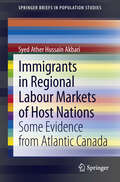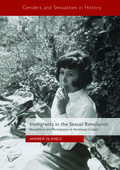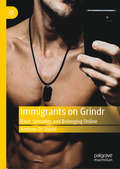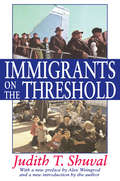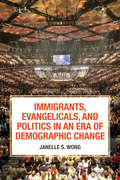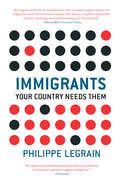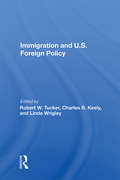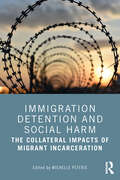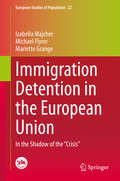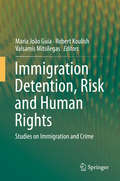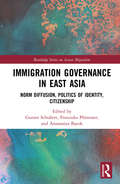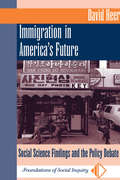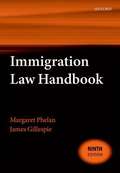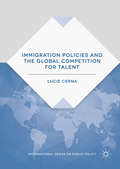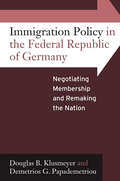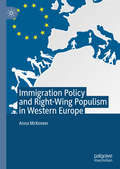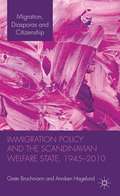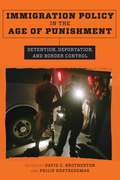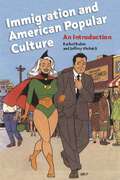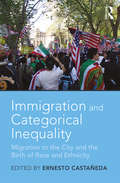- Table View
- List View
Immigrants in Regional Labour Markets of Host Nations
by Syed Ather AkbariThis book is the first to present a detailed analysis of economic integration of immigrants in smaller areas of their host nations. It uses Atlantic Canada as a case in point and uses unpublished data based on several databases of Statistics Canada and Citizenship and Immigration, Canada. It identifies best policy practices that can also be used in other countries to address demographic challenges similar to those facing Canada, for example population ageing and youth out-migration from smaller regions to larger regions, through immigration. Economic integration of immigrants in Atlantic Canada is faster and better than it is nationally. An overarching result is that an analysis of regional data can lead to very different policy conclusions than the analysis of national data, which means that it can be risky to devise immigration policy based only on national data. A clear message is that economic benefits from immigration can be enhanced by facilitating a broader geographic distribution of immigrants, rather than maintaining their concentration in a few larger urban regions. A must read for immigration and population policy makers, immigrant settlement agencies and academic researchers.
Immigrants in the Sexual Revolution
by Andrew Dj ShieldThis book focuses on the latter half of the twentieth century, when much of northwest Europe grew increasingly multicultural with the arrival of foreign workers and (post-)colonial migrants, whilst simultaneously experiencing a boom in feminist and sexual liberation activism. Using multilingual newspapers, foreign worker organizations' archives, and interviews, this book shows that immigrants in the Netherlands and Denmark held a variety of viewpoints about European gender and sexual cultures. Some immigrants felt solidarity with, and even participated in, European social movements that changed norms and laws in favor of women's equality, gay and lesbian rights, and sexual liberation. These histories challenge today's politicians and journalists who strategically link immigration to sexual conservatism, misogyny, and homophobia.
Immigrants on Grindr: Race, Sexuality and Belonging Online
by Andrew DJ ShieldThis book examines the role of hook-up apps in the lives of gay, bi, trans, and queer immigrants and refugees, and how the online culture of these platforms promotes belonging or exclusion. Within the context of the so-called European refugee crisis, this research focuses on the experiences of immigrants from especially Muslim-majority countries to the greater Copenhagen area, a region known for both its progressive ideologies and its anti-immigrant practices. Grindr and similar platforms connect newcomers with not only dates and sex, but also friends, roommates and other logistical contacts. But these socio-sexual platforms also become spaces of racialization and othering. Weaving together analyses of real Grindr profile texts, immigrant narratives, political rhetoric, and popular media, Immigrants on Grindr provides an in-depth look at the complex interplay between online and offline cultures, and between technology and society.
Immigrants on the Threshold
by Judith T. ShuvalThis first large-scale empirical work on the adjustment problems of immigrants in Israel is now updated with a new introduction by the author and a preface by Alex Weingrod. The extraordinary phenomenon of worldwide immigration to Israel has made this searching study of people in transit possible. "Immigrants on the Threshold" reports on the attitudes and behaviors of almost 2,000 people from twenty countries during their first year in Israel during the early years of mass migration. It is of particular interest as the phenomenon of integration becomes an issue for concern in many other parts of the world. "Immigrants on the Threshold" by Judith Shuval presents a theoretical framework closely intermeshed with rich empirical findings. No other work in this field approaches this study in either depth of theoretical analysis or in design and execution of data collection performed by conducting in-depth interviews and then using statistical analysis to quantify results in exacting and objective detail. It attempts to answer a number of critical questions: What factors in the immigrants' past and present condition their responses to the strain of transit? What is the role of commitment to the goal of the new society into which they must incorporate? What is the role of different social and economic backgrounds in determining patterns of acculturation? What factors affect the aspirations and mobility patterns of immigrants? The answers to these questions - the hypotheses formulated and the conclusions reached in "Immigrants on the Threshold" - contribute substantially to the fields of both sociology and social psychology. These answers, and the methods used to reach them, should be of interest to anyone in these fields and the field of applied social research, as well as those interested in Israel and questions of immigrant integration.
Immigrants, Evangelicals, and Politics in an Era of Demographic Change
by Janelle S. WongAs immigration from Asia and Latin America reshapes the demographic composition of the U.S., some analysts have anticipated the decline of conservative white evangelicals’ influence in politics. Yet, Donald Trump captured a larger share of the white evangelical vote in the 2016 election than any candidate in the previous four presidential elections. Why has the political clout of white evangelicals persisted at a time of increased racial and ethnic diversity? In Immigrants, Evangelicals, and Politics in an Era of Demographic Change, political scientist Janelle Wong examines a new generation of Asian American and Latino evangelicals and offers an account of why demographic change has not contributed to a political realignment. Asian Americans and Latinos currently constitute 13 percent of evangelicals, and their churches are among the largest, fastest growing organizations in their communities. While evangelical identity is associated with conservative politics, Wong draws from national surveys and interviews to show that non-white evangelicals express political attitudes that are significantly less conservative than those of their white counterparts. Black, Asian American, and Latino evangelicals are much more likely to support policies such as expanded immigration rights, increased taxation of the wealthy, and government interventions to slow climate change. As Wong argues, non-white evangelicals’ experiences as members of racial or ethnic minority groups often lead them to adopt more progressive political views compared to their white counterparts. However, despite their growth in numbers, non-white evangelicals—particularly Asian Americans and Latinos—are concentrated outside of swing states, have lower levels of political participation than white evangelicals, and are less likely to be targeted by political campaigns. As a result, white evangelicals dominate the evangelical policy agenda and are overrepresented at the polls. Also, many white evangelicals have adopted even more conservative political views in response to rapid demographic change, perceiving, for example, that discrimination against Christians now rivals discrimination against racial and ethnic minorities. Wong demonstrates that immigrant evangelicals are neither “natural” Republicans nor “natural” Democrats. By examining the changing demographics of the evangelical movement, Immigrants, Evangelicals, and Politics in an Era of Demographic Change sheds light on an understudied constituency that has yet to find its political home.
Immigrants: Your Country Needs Them
by Philippe LegrainImmigration divides our globalizing world like no other issue. We are swamped by illegal immigrants and infiltrated by terrorists, our jobs stolen, our welfare system abused, our way of life destroyed--or so we are told. At a time when National Guard units are deployed alongside vigilante Minutemen on the U.S.-Mexico border, where the death toll in the past decade now exceeds 9/11's, Philippe Legrain has written the first book about immigration that looks beyond the headlines. Why are ever-rising numbers of people from poor countries arriving in the United States, Europe, and Australia? Can we keep them out? Should we even be trying? Combining compelling firsthand reporting from around the world, incisive socioeconomic analysis, and a broad understanding of what's at stake politically and culturally, Immigrants is a passionate but lucid book. In our open world, more people will inevitably move across borders, Legrain says--and we should generally welcome them. They do the jobs we can't or won't do--and their diversity enriches us all. Left and Right, free marketeers and campaigners for global justice, enlightened patriots--all should rally behind the cause of freer migration, because They need Us and We need Them.
Immigration And Citizenship In An Enlarged European Union
by Simon McmahonA distinctive contribution to the politics of citizenship and immigration in an expanding European Union, this book explains how and why differences arise in responses to immigration by examining local, national and transnational dimensions of public debates on Romanian migrants and the Roma minority in Italy and Spain.
Immigration And U.s. Foreign Policy
by Robert W. TuckerIn this inter disciplinary study, a distinguished group of demographers, historians, and political scientists assess the relationship between immigration and foreign policy in the United States. First re-examining the consequences of the 19th-century and inter-war migrations, the authors then explore the origins of US refugee policy and refugee mig
Immigration Detention and Social Harm: The Collateral Impacts of Migrant Incarceration
by Michelle PeterieThis interdisciplinary edited collection is the first internationally to comprehensively explore the harms immigration detention imposes beyond the ‘detainee’. Bringing together research from North America, the UK, Europe and Australia, it shows how the harms immigration detention imposes ramify beyond singular bodies, moments and locations – reverberating through families and communities and echoing across time.The book is structured in three parts. Part One: Human Costs, examines the harms immigration detention imposes on people who are not personally incarcerated, but whose lives are nonetheless entangled with detention regimes. Part Two: Societal Consequences highlights the corrosive impacts of immigration detention at the societal level, including the role migrant incarceration plays in naturalising and perpetuating inequalities and injustices. Part Three: Ending the Harm interrogates the possibilities of detention reform and detention abolition.This book will be a key reference text for scholars and students in the social and behavioural sciences who are interested in immigration detention, human rights and/or incarceration.
Immigration Detention in the European Union: In the Shadow of the “Crisis” (European Studies of Population #22)
by Michael Flynn Izabella Majcher Mariette GrangeThis book offers a unique comparative assessment of the evolution of immigration detention systems in European Union member states since the onset of the “refugee crisis.” By applying an analytical framework premised on international human rights law in assessing domestic detention regimes, the book reveals the extent to which EU legislation has led to the adoption of laws and practices that may disregard fundamental rights and standards. While emphasizing policies and laws adopted in response to the “refugee crisis,” the volume also shows how these policies have evolved—and in many cases grown more restrictive—even as the “crisis” has begun to recede from the borders of many European countries. To sharpen awareness of contrasting developments across the region, the book’s country chapters are organised into geographic sections that reveal how variations in migration pressures have in some cases resulted in contrasting detention practices even as the EU directives have sought to harmonise immigration laws. A critical focus of the book are the evolving domestic norms related to grounds for detention, length of detention, non-custodial "alternatives to detention," the treatment of children, and conditions of detention. With its systematic and comparative assessment of immigration detention regimes across the EU, the book will be helpful for both academics and practitioners who seek a comprehensive guide to the evolution of one of today’s more important human rights dilemmas—states’ efforts to control global migration.
Immigration Detention, Risk and Human Rights
by Maria João Guia Robert Koulish Valsamis MitsilegasThis book offers a brand new point of view on immigration detention, pursuing a multidisciplinary approach and presenting new reflections by internationally respected experts from academic and institutional backgrounds. It offers an in-depth perspective on the immigration framework, together with the evolution of European and international political decisions on the management of immigration. Readers will be introduced to new international decisions on the protection of human rights, together with international measures concerning the detention of immigrants. In recent years, International Law and European Law have converged to develop measures for combatting irregular immigration. Some of them include the criminalization of illegally entering a member state or illegally remaining there after legally entering. Though migration has become a great challenge for policymakers, legislators and society as a whole, we must never forget that migrants should enjoy the same human rights and legal protection as everyone else.
Immigration Economics
by George J. BorjasMillions of people--nearly 3 percent of the world's population--no longer live in the country where they were born. Every day, migrants enter not only the United States but also developed countries without much of a history of immigration. Some of these nations have switched in a short span of time from being the source of immigrants to being a destination for them. International migration is today a central subject of research in modern labor economics, which seeks to put into perspective and explain this historic demographic transformation. Immigration Economics synthesizes the theories, models, and econometric methods used to identify the causes and consequences of international labor flows. Economist George Borjas lays out with clarity and rigor a full spectrum of topics, including migrant worker selection and assimilation, the impact of immigration on labor markets and worker wages, and the economic benefits and losses that result from immigration. Two important themes emerge: First, immigration has distributional consequences: some people gain, but some people lose. Second, immigrants are rational economic agents who attempt to do the best they can with the resources they have, and the same holds true for native workers of the countries that receive migrants. This straightforward behavioral proposition, Borjas argues, has crucial implications for how economists and policymakers should frame contemporary debates over immigration.
Immigration Governance in East Asia: Norm Diffusion, Politics of Identity, Citizenship (Routledge Series on Asian Migration)
by Gunter Schubert, Franziska Plümmer, and Anastasiya BayokThis book analyzes immigration policies in East Asia in the context of contemporary global migration flows and mobility. To assess how global norms of migration have impacted the East Asian migration region and explore regional migration trends, the book contains 13 case studies which investigate the regulation of immigration in China, Hong Kong, Japan, South Korea, and Taiwan. Three analytical strands, namely, norm diffusion, identity politics, and citizenship, build the theoretical framework for the case studies which investigate how regional and national norms, discourses, and institutions affect local communities and migration patterns. In particular, the book analyzes contemporary issues such as immigration policy reforms, practices of inclusion and exclusion in local communities, and discourses on multiculturalism and risk. The book utilizes a comparative perspective which enables readers to reflect on the role of national identity, international organizations and law, public security concerns, and labour market demands in the articulation and implementation of contemporary immigration policy in East Asia. This book substantially complements the existing literature on immigration governance and interregional migration mobility in East Asia and will be of interest to academics in the fields of East Asian studies, public policy, immigration and migration studies, and comparative politics.
Immigration In America's Future: Social Science Findings And The Policy Debate (New Perspectives In Sociology Ser.)
by David HeerImmigration policy is one of the most contentious issues facing the United States today. The bitter national debate over California's Proposition 187, the influx of Cuban refugees into Miami, and the continuous, often illegal, crossings over the Mexican border into Texas and California are just a few of the episodes that have created a furor on local, state, and federal levels.In this timely and informative book, David Heer invites readers to examine the data and the trends of immigration to the United States and, ultimately, make up their own minds about what our national immigration policy ought to be. He demonstrates how social science findings, together with a conscious recognition of our individual values, are necessary for the formation of a balanced policy for immigration.Some of the the nation's collective values that may be affected by U.S. immigration policy are the standard of living in this country, the preservation of existing American culture, ethnic and class conflict, and the power of the United States in international affairs. Heer examines the impact of these values on immigration policy and traces the history of U.S. immigration and immigration law and patterns of immigration to the United States. Finally, he offers proposals for change to existing immigration policy.
Immigration Judicial Reviews: An Empirical Study (Palgrave Socio-Legal Studies)
by Robert Thomas Joe TomlinsonThis book analyses how the system of immigration judicial reviews works in practice, as an area which has, for decades, constituted the majority of judicial review cases and is politically controversial. Drawing upon extensive empirical research and unprecedented research access, it explores who brings judicial review challenges against immigration decisions and why, the type of immigration decisions that are challenged, how cases proceed through the judicial review process, how cases are settled out of court, and how judicial review interacts with other legal and non-legal remedies. It also examines the quality of immigration judicial review claims and the quality of the initial administrative decisions being challenged. Through developing a novel account of the operation of the immigration judicial review system in practice and the lived experience of it by judges, representatives, and claimants, this book adds a significant new perspective to the wider understanding of judicial review.
Immigration Law Handbook
by Margaret Phelan James GillespieNow in its ninth edition, the Immigration Law Handbook continues to bring together all the key materials relevant to Immigration and Asylum Law in one volume, providing an essential reference tool for those working in the area. This new edition includes the text of the Immigration Act 2014 which will make substantial changes to existing legislation, in particular the 1971 and 2002 acts and restricts access to housing and other services. Other texts provided include the new Dublin III EU regulations and recent UNHCRguidelines on refugee claims. This coverage of recent new legislation sits alongside existing important legislation to maintain the strengths of the handbook as a reference tool whilst providing the reader with up-to-date access to all new developments in a single volume. The Immigration Law Handbook has established itself as the standard in the field and has become an invaluable resource for immigration practitioners including Asylum and Immigration Tribunal judges and barristers, and solicitors and caseworkers working in immigration, asylum, and human rights law.
Immigration Law for Paralegals (3rd Edition)
by Gloria Roa Bodin Maria Isabel CasablancaImmigration Law for Paralegals is an indispensable and practical guide on U.S. immigration, citizenship and visa procedures for instructing and training students or anyone interested in a career as an immigration paralegal or legal assistant. The new edition has a new chapter on court litigation which also includes writs of mandamus and habeas corpus with federal courts.
Immigration Policies and the Global Competition for Talent
by Lucie CernaThis book examines the variation in high-skilled immigration policies in OECD countries. These countries face economic and social pressures from slowing productivity, ageing populations and pressing labour shortages. To address these inter-related challenges, the potential of the global labour market needs to be harnessed. Countries need to intensify their efforts to attract talented people - the best and the brightest. While some are excelling in this new marketplace, others lag behind. The book explores the reasons for this, analysing the interplay between interests and institutions. It considers the key role of coalitions between labour (both high- and low-skilled) and capital. Central to the analysis is a newly constructed index of openness to high-skilled immigrants, supplemented by detailed case studies of France, Germany, Sweden, the United Kingdom and the United States. The book contributes to the literature on immigration, political economy and public policy, and appeals to academic and policy audiences.
Immigration Policy In The Federal Republic Of Germany
by Demetrios G. Papademetriou Douglas B. KlusmeyerGerman migration policy now stands at a major crossroad, caught between a fifty-year history of missed opportunities and serious new challenges. Focusing on these new challenges that German policy makers face, the authors, both internationally recognized in this field, use historical argument, theoretical analysis, and empirical evaluation to advance a more nuanced understanding of recent initiatives and the implications of these initiatives. Their approach combines both synthesis and original research in a presentation that is not only accessible to the general educated reader but also addresses the concerns of academic scholars and policy analysts. This important volume offers a comprehensive and critical examination of the history of German migration law and policy from the Federal Republic's inception in 1949 to the present.
Immigration Policy and Right-Wing Populism in Western Europe
by Anna McKeeverImmigration has become one of the central issues dominating the agenda of political parties, and has also played a crucial role in the rise of right-wing populism in Western Europe. This book explores the role of conservative parties in immigration policy change. The following questions are addressed: What explains the introduction of restrictive immigration policies across a number of European states? Why do conservative parties choose to toughen their immigration policy stances? How can we explain the variation in the factors that affect conservative parties’ immigration policy-making logics? What mechanisms account for the dynamics of immigration policy change or policy deadlock? Based on interviews with political elites and policy makers in the UK, Switzerland and France, the book explains why governmental conservative parties in these countries revised their immigration policy stances and steered immigration policy in a more restrictive direction between 2002 and 2015.
Immigration Policy and the Scandinavian Welfare State 1945–2010
by Grete Brochmann Anniken Hagelund Karin Borevi Heidi Vad Jønsson Klaus PetersenThis book explores the historical development of post-war immigration politics in Norway, Sweden and Denmark from the perspective of the welfare state, examining how welfare states with high ambitions, generous and inclusive welfare schemes and a strong sense of egalitarianism cope with the pressures of immigration and growing diversities.
Immigration Policy in the Age of Punishment: Detention, Deportation, and Border Control (Studies In Transgression Ser.)
by Philip Kretsedemas Edited by David C. BrothertonThe events of 2016 catapulted immigration policy to the forefront of public debate, and Donald Trump’s administration has signaled a harsh turn in enforcement. Yet the deportation, detention, and border-control policies that North American and European countries have embraced are by no means new. In this book, sociologists David C. Brotherton and Philip Kretsedemas bring together an interdisciplinary group of contributors to reconsider the immigration policies of the Obama era and beyond in terms of a decades-long “age of punishment.”Immigration Policy in the Age of Punishmenttakes a critical, interdisciplinary, and transnational look at current issues surrounding immigration in the U.S. and abroad. It examines key features of this age of punishment, connecting neoliberal governance, global labor markets, and the national obsession with securing borders to explain critical research and theory on immigration enforcement. Contributors document the continuities between presidential administrations and across countries from many perspectives, with chapters discussing Canada, Australia, France, the UK, the Dominican Republic, and Mexico in addition to the U.S. They offer macro-level analyses of deportations and border enforcement, analyses of national policy and jurisprudence, and ethnographic accounts of the daily life experience of the prison-to-deportation pipeline, the making of deportability, and post-deportation transitions for noncitizens. This book highlights new directions in critical immigration policy and enforcement and deportation studies with the aim of problematizing the age of punishment that currently reigns over borders and those who seek to cross them.
Immigration and Acculturation in Brazil and Argentina
by May E. BletzAn exploration of questions of nationality in Brazil and Argentina, at the time when the cities were flooded with impoverished European immigrants. The author argues that processes of representation and identity formation between national and immigrant groups have to be examined within the historical context of the host nations.
Immigration and American Popular Culture: An Introduction (Nation of Nations #4)
by Rachel Lee Rubin Jeffrey MelnickA unique study that hones in on the cross-section and interdependency of immigration and American cultural productionHow does a 'national' popular culture form and grow over time in a nation comprised of immigrants? How have immigrants used popular culture in America, and how has it used them?Immigration and American Popular Culture looks at the relationship between American immigrants and the popular culture industry in the twentieth century. Through a series of case studies, Rachel Rubin and Jeffrey Melnick uncover how specific trends in popular culture—such as portrayals of European immigrants as gangsters in 1930s cinema, the zoot suits of the 1940s, the influence of Jamaican Americans on rap in the 1970s, and cyberpunk and Asian American zines in the1990s—have their roots in the complex socio-political nature of immigration in America.Supplemented by a timeline of key events and extensive suggestions for further reading, Immigration and American Popular Culture offers at once a unique history of twentieth century U.S. immigration and an essential introduction to the major approaches to the study of popular culture. Melnick and Rubin go further to demonstrate how completely and complexly the processes of immigration and cultural production have been intertwined, and how we cannot understand one without the other.
Immigration and Categorical Inequality: Migration to the City and the Birth of Race and Ethnicity
by Ernesto CastañedaImmigration and Categorical Inequality explains the general processes of migration, the categorization of newcomers in urban areas as racial or ethnic others, and the mechanisms that perpetuate inequality among groups. Inspired by the pioneering work of Charles Tilly on chain migration, transnational communities, trust networks, and categorical inequality, renowned migration scholars apply Tilly’s theoretical concepts using empirical data gathered in different historical periods and geographical areas ranging from New York to Tokyo and from Barcelona to Nepal. The contributors of this volume demonstrate the ways in which social boundary mechanisms produce relational processes of durable categorical inequality. This understanding is an important step to stop treating differences between certain groups as natural and unchangeable. This volume will be valuable for scholars, students, and the public in general interested in understanding the periodic rise of nativism in the United States and elsewhere.
